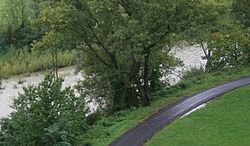Taro (river)
| Taro | |
|---|---|
 The Taro atBorgotaro | |
 Course of the Taro. | |
| Location | |
| Country | Italy |
| Physical characteristics | |
| Source | |
| • location | Ligurian Apennines,Monte Penna |
| • elevation | about 1,300 m (4,300 ft) |
| Mouth | |
• location | PonearGramignazzo(PR) |
• coordinates | 45°00′08″N10°15′21″E/ 45.0022°N 10.2558°E |
| Length | 126 km (78 mi) |
| Basin size | 2,026 km2(782 sq mi) |
| Discharge | |
| • average | 30 m3/s (1,100 cu ft/s) |
| Basin features | |
| Progression | Po→Adriatic Sea |
| Tributaries | |
| • left | Ceno,Stirone |
TheTaro(LatinTarus) is ariverinEmilia-Romagna,in northernItaly.It is a tributary of thePoand is 126 kilometres (78 mi) long. It flows almost entirely in theprovince of Parma,west of the cityParma.The Taro flows into the Po near Gramignazzo, afrazioneof thecomuneofSissa,north of Parma.
TheVal di Taro,or Taro valley, thedrainage basinof the river, occupies an area of 2,026 square kilometres (782 sq mi). The principal affluents of the Taro are theCeno,RecchioandStirone;others are theGotraandTarodine.Both the Taro and the Ceno rise onMonte Penna,elevation 1,735 metres (5,692 ft), in theApennine Mountainson the border between the provinces ofGenoaand Parma.
The river shows strong seasonal variability. In summer it can easily dry, while in rainy periods it can reach adischargeof 1,000 cubic metres per second (35,000 cu ft/s): this value can double on rare occasions, knownItalian:piene centennali,"centennial floods", such as that of November 9, 1982.
The Val di Taro was of strategic importance during the Middle Ages, as it was traversed by theVia Francigena,the pilgrim route and main connection betweenRomeandFrancein that era.
About 20 kilometres (12 mi) of the river course betweenFornovo di TaroandPonte Taroconstitutes the protected area of theParco fluviale Regionale del Taro,the Taro regional natural park. The area of the park includes the river bed itself, with numerous islets of sand and gravel and wetland areas, and surrounding areas of woodland, scrub and cultivated soil; it has a wide variety of vegetation and fauna.[1]
Following the French conquest of Italy in theNapoleonic Wars,the river gave its name to adépartement,theDépartement du Taro.
References
[edit]- ^L'Area Protetta(in Italian). Parco fluviale Regionale del Taro, 2 June 2010. "The protected area". Accessed June 2013.
External links
[edit] Media related toTaro riverat Wikimedia Commons
Media related toTaro riverat Wikimedia Commons- Taro Park Website(in Italian)
